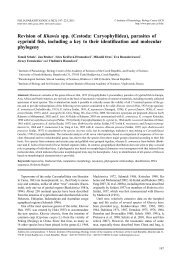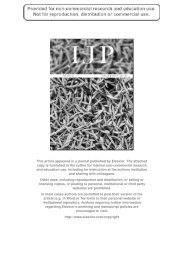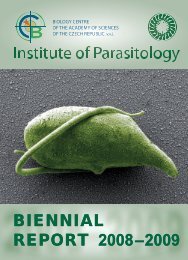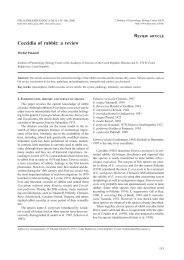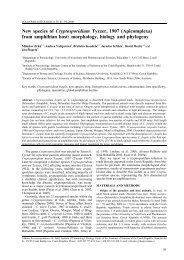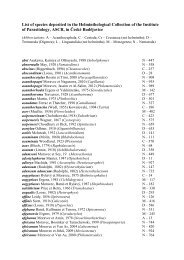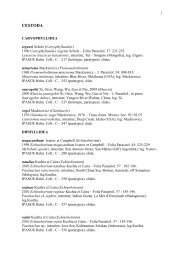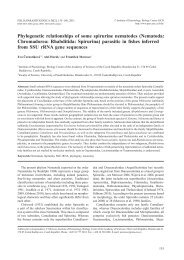Ahead of print online version Two species of Rhabdochona ...
Ahead of print online version Two species of Rhabdochona ...
Ahead of print online version Two species of Rhabdochona ...
You also want an ePaper? Increase the reach of your titles
YUMPU automatically turns print PDFs into web optimized ePapers that Google loves.
microscopy has shown that they represent a new <strong>species</strong>.<br />
its description is presented herein. in addition, a single<br />
gravid female specimen <strong>of</strong> <strong>Rhabdochona</strong> (<strong>Rhabdochona</strong>)<br />
sp. was recorded from the same host <strong>species</strong> (L. kersin)<br />
in the same locality as the above-mentioned new <strong>species</strong><br />
and data on its morphology are also provided.<br />
Luciobarbus kersin is a subtropical benthopelagic<br />
freshwater fish native in the Tigris River basin, distributed<br />
in iran, iraq and turkey (Froese and Pauly 2011).<br />
MATeRIAlS ANd MeTHodS<br />
During occasional examinations <strong>of</strong> cyprinid fishes from the<br />
lesser Zab river at the town <strong>of</strong> Alton Kupri and the greater Zab<br />
river at the town <strong>of</strong> gwer (tributaries <strong>of</strong> the tigris river) near<br />
the City <strong>of</strong> Erbil, Kurdistan Region, northern Iraq, carried out in<br />
June and July <strong>of</strong> 2011, <strong>Rhabdochona</strong> specimens (n = 78) were<br />
collected from the barbel Luciobarbus kersin; also specimens<br />
<strong>of</strong> Procamallanus sp. (only females) were present in L. kersin<br />
from the greater Zab river. Nematodes collected from the intestine<br />
were fixed and stored in 70% ethanol. For light microscopical<br />
examination (LM), nematodes were cleared with glycerine.<br />
Drawings were made with the aid <strong>of</strong> a Zeiss microscope drawing<br />
attachment. specimens used for scanning electron microscopy<br />
(SEM) were first transferred to 4% formaldehyde solution;<br />
later they were postfixed in 1% osmium tetroxide (in phosphate<br />
buffer), dehydrated through a graded acetone series, criticalpoint-dried<br />
and sputter-coated with gold; they were examined<br />
using a JEOL JSM-7401F scanning electron microscope at an<br />
accelerating voltage <strong>of</strong> 4 kV gB low. All measurements are<br />
in micrometres unless otherwise indicated. Fish names follow<br />
FishBase (Froese and Pauly 2011).<br />
ReSulTS<br />
Family Rhabdochonidae travassos, Artigas et Pereira,<br />
1928<br />
<strong>Rhabdochona</strong> (Globochona) kurdistanensis sp. n.<br />
Figs. 1, 2<br />
description: Medium sized nematodes with finely<br />
transversely striated cuticle (Fig. 2D). lateral alae absent.<br />
Mouth oval to roughly hexagonal (Figs. 1E, 2A,B). Four<br />
small submedian cephalic papillae and two lateral amphids<br />
present (Figs. 1E, 2A,B). Prostom funnel-shaped,<br />
thick-walled, with distinct basal teeth (Fig. 1C,D); anterior<br />
teeth 8 in number, 2 dorsal, 2 ventral and 4 lateral<br />
(2 on each side) (Figs. 1E, 2A,B). Deirids small, bifurcate,<br />
situated at level <strong>of</strong> posterior half <strong>of</strong> vestibule (Figs. 1B,c,<br />
2C). Excretory pore short distance posterior to nerve ring<br />
level (Fig. 1A,C). Tail <strong>of</strong> both sexes conical, its tail tip<br />
rounded, bearing cuticular outgrowths.<br />
Male (3 specimens; measurements <strong>of</strong> holotype in parentheses):<br />
Body 10.85–12.28 (10.85) mm long, maximum<br />
width 177–218 (177). Vestibule including prostom<br />
183–189 (183); prostom 24–27 (24) long and 21–24 (24)<br />
wide in lateral aspect. Muscular oesophagus 360–393<br />
(360) long, width 39–42 (39); glandular oesophagus<br />
140<br />
<strong>Ahead</strong> <strong>of</strong> <strong>print</strong> <strong>online</strong> <strong>version</strong><br />
5.24–6.12 (5.24) mm long, width 111–147 (111); length<br />
ratio <strong>of</strong> both parts <strong>of</strong> oesophagus 1:14.4–15.6 (1:14.5).<br />
Entire oesophagus and vestibule representing 51–57<br />
(53)% <strong>of</strong> body length. Nerve ring, excretory pore and<br />
deirids 246–261 (261), 394–422 (394) and 126–159<br />
(159), respectively, from anterior extremity. Subventral<br />
preanal papillae occurred in following combinations: 9+9<br />
and 10+10 (9+9); 2 (2) additional pairs <strong>of</strong> lateral preanal<br />
papillae situated between second and third and third and<br />
fourth pairs <strong>of</strong> subventral papillae (counting from cloacal<br />
opening). Postanal papillae: 6 pairs, <strong>of</strong> which 5 (5) pairs<br />
subventral and 1 (1) lateral (Figs. 1K, 2F,g). Precloacal<br />
ventral cuticular ornamentation (area rugosa) formed by<br />
numerous transverse bands with 3–4 transverse grooves,<br />
separated from each other by band-like fields bearing<br />
many low longitudinal, parallel ridges (Figs. 1H, 2H).<br />
Left spicule markedly short, 180–204 (204) long; its shaft<br />
105–126 (126) long, representing 53–67 (62)% <strong>of</strong> entire<br />
spicule length; distal tip slightly widened, moderately bifurcate<br />
(Fig. 1F). right spicule boat-shaped, 66–90 (66)<br />
long, without dorsal barb at distal tip (Fig. 1g). length<br />
ratio <strong>of</strong> spicules 1:2.00–3.09 (1:3.09). tail 282–303 (282)<br />
long, with rounded tip bearing numerous minute spinelike<br />
protrusions (Fig. 1J,K).<br />
Female (6 gravid specimens; measurements <strong>of</strong> allotype<br />
in parentheses): Body 12.28–18.99 (16.58) mm long,<br />
maximum width 190–326 (326). Vestibule including prostom<br />
180–210 (210) long; prostom 27–30 (30) long and<br />
24–27 (27) wide. Muscular oesophagus 360–448 (435)<br />
long, width 36–48 (39); glandular oesophagus 5.54–7.14<br />
(6.80) mm long, width 120–163 (163); length ratio <strong>of</strong><br />
both parts <strong>of</strong> oesophagus 1:15.2–17.8 (1:15.2). Entire<br />
oesophagus and vestibule representing 41–53 (45)%<br />
<strong>of</strong> body length. Nerve ring, excretory pore and deirids<br />
240–273 (273), 326–449 (449) and 135–141 (138), respectively,<br />
from anterior extremity. Tail conical, 198–249<br />
(237) long, with rounded tip bearing two lateral denticulate<br />
outgrowths 3–6 (6) long and 9–15 (15) wide; each<br />
outgrowth distally subdivided into 4 horn-like projections<br />
(Fig. 2D,E). Vulva postequatorial, 7.93–12.50 (8.95) mm<br />
from anterior extremity, at 54–66 (54)% <strong>of</strong> body length;<br />
vulval lips not elevated. Muscular vagina directed posteriorly<br />
from vulva. Eggs oval, thick-walled, embryonated,<br />
size 39–42 × 27–30 (39–42 × 27), with smooth surface<br />
(Fig. 1L); thickness <strong>of</strong> egg wall 3 (3).<br />
t y p e h o s t : Luciobarbus kersin (Heckel) (cyprinidae,<br />
cypriniformes) (body length 18–65 cm).<br />
s i t e o f i n f e c t i o n : intestine.<br />
T y p e l o c a l i t y : Greater Zab River (36–37°N, 43–44°E)<br />
(Tigris River basin) at Gwer, about 44 km southwest <strong>of</strong> Erbil<br />
city, Kurdistan region, northern iraq (collected 13 June<br />
2011).<br />
O t h e r l o c a l i t y : Lesser Zab River (34–36°N, 43–46°E)<br />
(Tigris River basin) at Alton Kupri, 45 km south <strong>of</strong> Erbil City<br />
(collected 11 July 2011).



